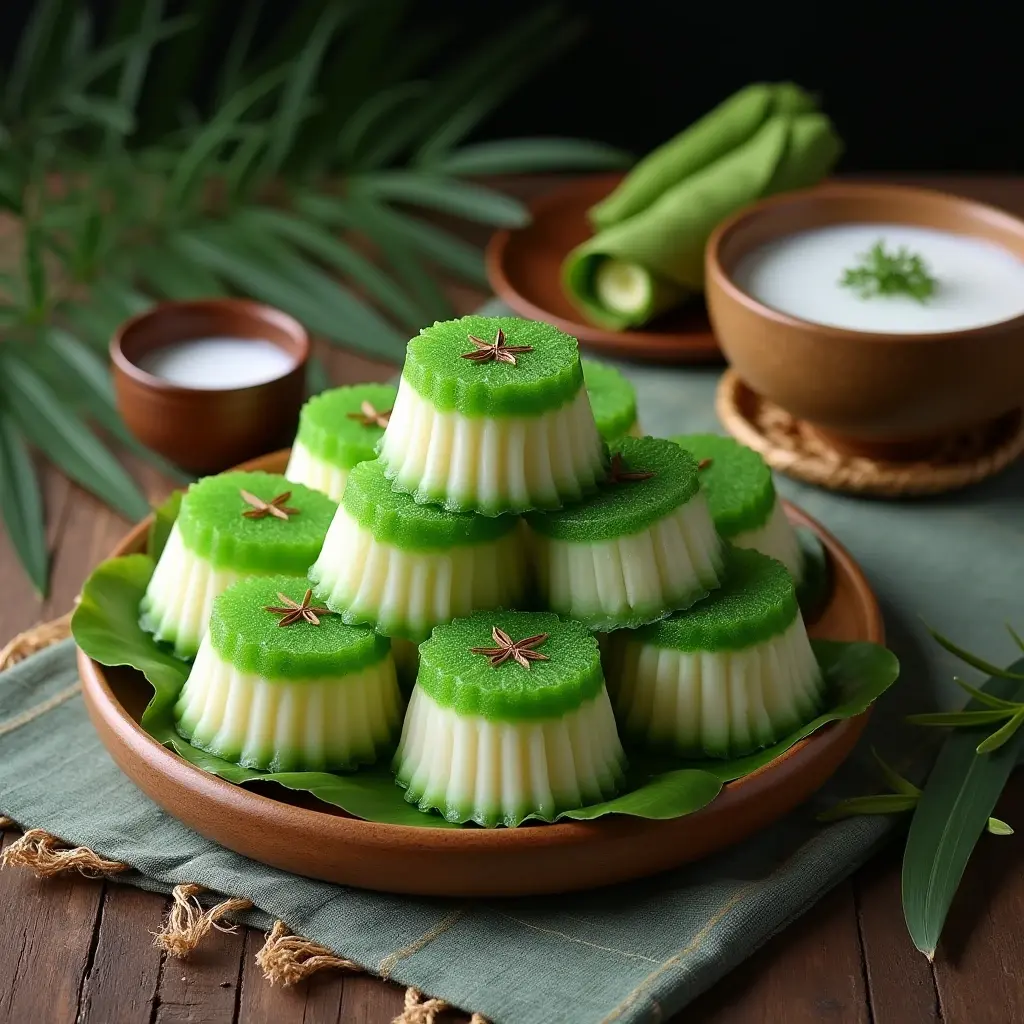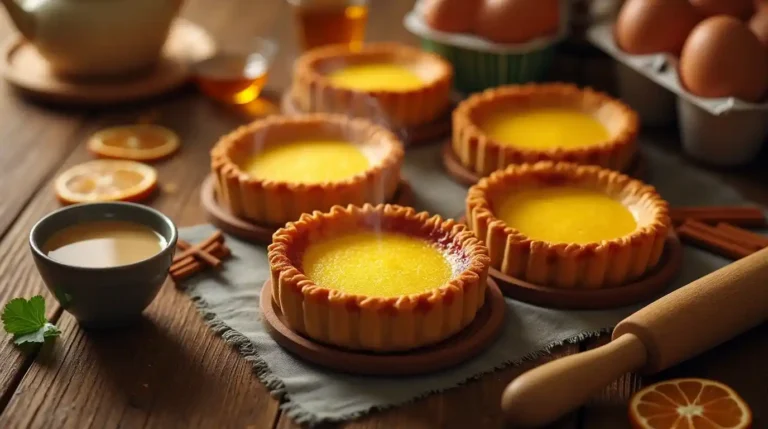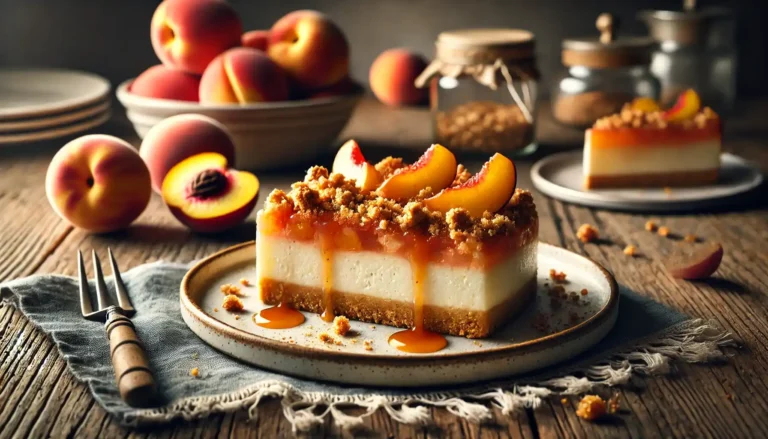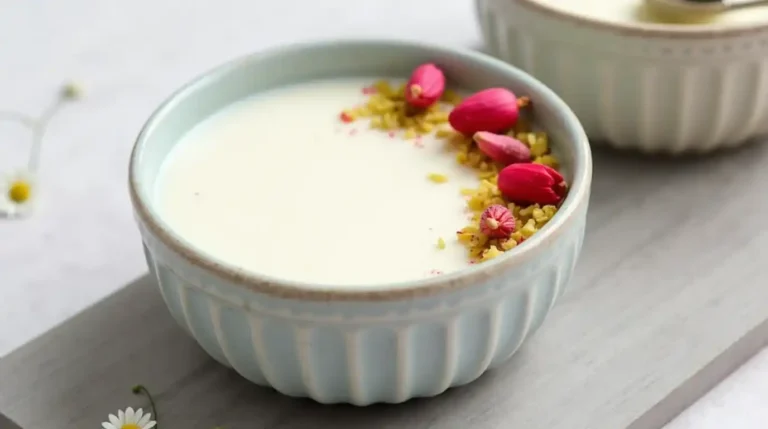Kuih Seri Muka: A Traditional Malaysian Delight
Kuih Seri Muka is an iconic traditional Malaysian dessert that reflects the rich cultural heritage and culinary artistry of Southeast Asia. This two-layered sweet treat, with its glutinous rice base topped with a fragrant pandan custard, has a special place in the hearts of Malaysians and food enthusiasts worldwide. In this article, we explore the history, ingredients, preparation, variations, and cultural significance of Kuih Seri Muka
Table of Contents
The Origins and Cultural Significance of Kuih Seri Muka
Kuih Seri Muka holds a long-standing tradition in Malaysian cuisine, believed to have been passed down through generations. The dessert features prominently in Malay festivities, family gatherings, and celebrations, symbolizing unity, prosperity, and cultural identity.
Historically, kuih-series are often created using locally sourced ingredients such as glutinous rice, coconut milk, and pandan leaves, which not only highlight Malaysia’s tropical bounty but also showcase the regional culinary techniques. The two-layered design of Kuih Seri Muka provides not just aesthetic appeal but also a delightful combination of textures and flavors — from the sticky, chewy rice to the smooth and aromatic custard.
In Malaysian culture, kuih-series like Seri Muka are often served during festive seasons like Hari Raya Aidilfitri and weddings, reflecting hospitality, tradition, and a strong community bond. Preparing Kuih Seri Muka is usually a communal activity, with family members coming together to share the joy of crafting this beloved dessert.
Understanding the Ingredients of Kuih Seri Muka
One of the reasons for the dessert’s distinctiveness lies in its simple yet refined ingredients. Each element plays a crucial role in creating its signature flavor and texture.
Glutinous Rice Base
The bottom layer of Kuih Seri Muka is made primarily from glutinous rice (also known as sticky rice) that has been soaked, steamed, and sometimes infused with coconut milk and salt. The glutinous rice forms the foundation of the dessert, providing a chewy texture that contrasts wonderfully with the smooth topping.
Pandan Custard Topping
The top layer comprises a silky, fragrant pandan custard that gives the dessert its characteristic vibrant green hue. The custard is made from a mixture of eggs, sugar, coconut milk, and pandan leaf extract. The pandan extract not only imparts a stunning color but also a unique, aromatic flavor that captures the essence of tropical Southeast Asian cooking.
Coconut Milk and Pandan Leaves
Coconut milk plays a dual role in both layers: it lends richness to the glutinous rice and the custard, while also blending harmoniously with the natural sweetness of the other ingredients. Pandan leaves are essential, as they infuse the custard with a distinct aroma and a bright green color that is both visually appealing and appetizing.
The Traditional Preparation of Kuih Seri Muka
Preparing Kuih Seri Muka at home can be a rewarding culinary journey. While there are many regional variations, the following is a step-by-step guide to creating this traditional dessert:
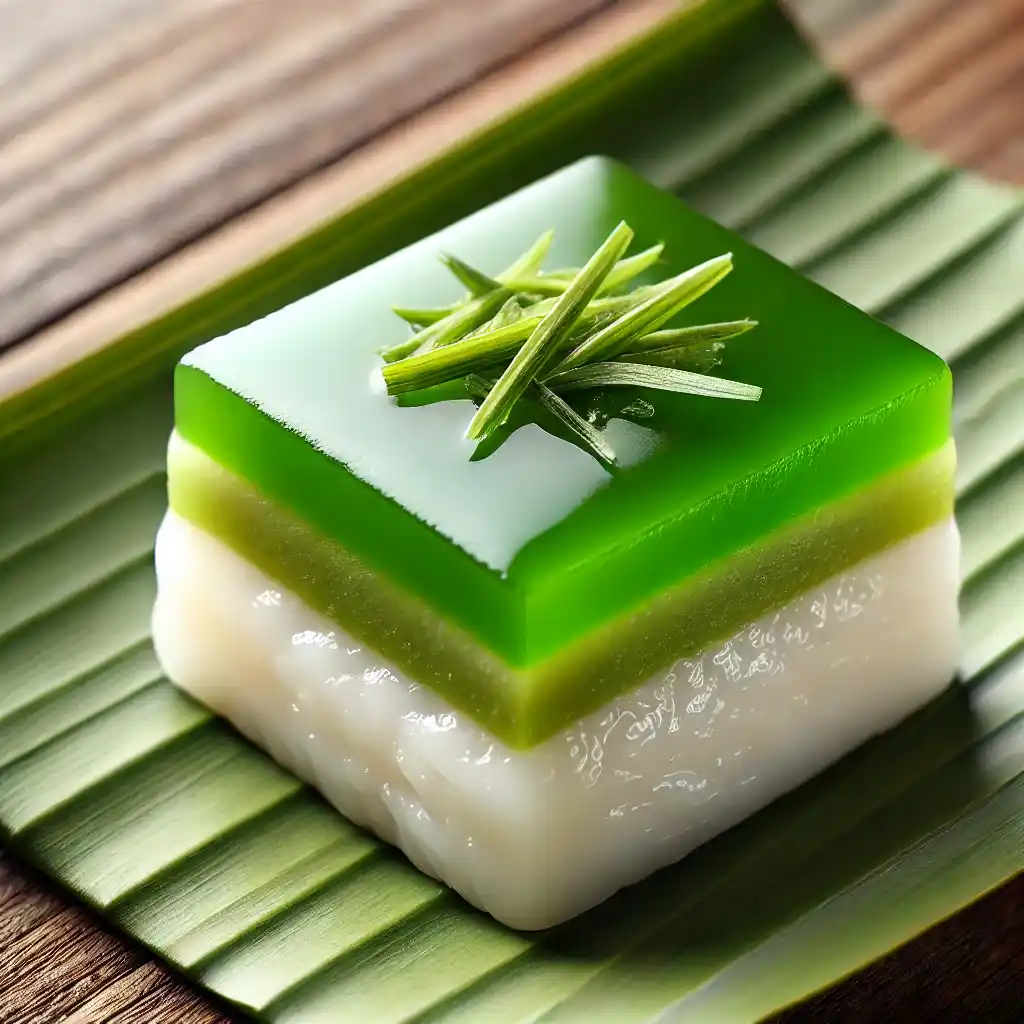
Preparing the Glutinous Rice Base
- Soaking the Rice: Begin by soaking glutinous rice in water for several hours or overnight. Soaking helps to soften the rice grains and ensures an even texture when steamed.
- Mixing with Coconut Milk: Drain the soaked rice and mix it with coconut milk, a pinch of salt, and a bit of sugar. The coconut milk enriches the rice, adding a subtle sweetness and creaminess.
- Steaming: Place the rice mixture in a steamer lined with a banana leaf or parchment paper to prevent sticking. Steam until the rice is fully cooked and sticky.
- Setting the Base: Once cooked, transfer the glutinous rice into a baking dish or mold, press it down firmly to form a smooth layer, and let it cool.
Making the Pandan Custard Topping
- Extracting Pandan Juice: Blend fresh pandan leaves with a little water and strain to obtain a fragrant pandan juice. Alternatively, you can use pandan extract available in stores.
- Preparing the Custard Mixture: In a mixing bowl, beat eggs and sugar until well combined, then mix in coconut milk and the pandan juice. The mixture should be smooth and homogenous, with the signature green color coming from the pandan.
- Straining the Custard: For a silky texture, strain the custard mixture to remove any lumps or bits of pandan leaf residue.
Assembling Kuih Seri Muka
- Pouring the Custard: Carefully pour the pandan custard mixture over the cooled glutinous rice base, ensuring an even layer on top. The ratio between the two layers can be adjusted according to preference, though the custard layer is often thinner than the rice base.
- Steaming Again: Steam the assembled dessert for a further 15-20 minutes until the custard is set and no longer jiggles in the center. The gentle steaming process ensures the custard cooks evenly without developing cracks on the surface.
- Cooling and Serving: Allow Kuih Seri Muka to cool completely before cutting into squares or diamond shapes. The dessert can be served at room temperature and is often accompanied by a cup of tea or coffee.
Variations and Regional Differences
While the basic recipe of Kuih Seri Muka remains consistent, there are regional variations that reflect local tastes and creative twists:
Flavor Enhancements
Some modern adaptations include adding ingredients like grated pandan leaves to the rice for extra flavor, or incorporating subtle hints of pandan essence into the rice layer. Others experiment with color by adding food coloring or natural coloring agents, although traditionalists typically prefer the natural green tint from pandan.
Presentation Styles
Regional styles might also influence the presentation. In some areas, the custard layer may be decorated with small bits of edible flowers, toasted coconut flakes, or pandan chiffon strips. These embellishments not only enhance the visual appeal but also add an extra layer of texture and flavor.
Alternative Cooking Methods
While steaming is the most traditional method of preparing Kuih Seri Muka, some home cooks choose to bake the custard layer in a water bath to achieve a similar effect. This method can result in a slightly different texture but still preserves the dish’s essential taste and aroma.
The Nutritional Value of Kuih Seri Muka
Like many traditional desserts, Kuih Seri Muka is a treat best enjoyed in moderation. Although it is rich in flavor, the dessert primarily consists of glutinous rice, coconut milk, and eggs, providing a source of energy through carbohydrates and fats. It also contains small amounts of vitamins and minerals derived from coconut and pandan leaves.
Dietary Considerations
- Gluten-Free Option: Because the dessert uses glutinous rice instead of wheat flour, Kuih Seri Muka is naturally gluten-free, making it an excellent option for those with gluten sensitivities.
- Dairy-Free and Vegan Adaptations: For those who are vegan or dairy-free, coconut milk provides a creamy base without the use of dairy. By substituting traditional eggs with plant-based alternatives, a vegan version of the custard layer can be created, although this may slightly alter the flavor and texture.
However, given its high sugar and fat content, Kuih Seri Muka should be enjoyed as an occasional indulgence rather than a daily snack, particularly by those monitoring their dietary intake.
Pairing Kuih Seri Muka with Beverages and Other Dishes
Kuih Seri Muka pairs wonderfully with several traditional beverages and complementary snacks. Its sweet, aromatic flavor works well with:
Teh Tarik
Teh Tarik, the famous pulled tea of Malaysia, has a creamy, frothy texture that provides a delightful contrast to the sticky and aromatic Kuih Seri Muka. The sweetness of the tea balances the richness of the dessert, creating a harmonious pairing.
Kopi O
A cup of strong black coffee (Kopi O) is another popular beverage to accompany Kuih Seri Muka. The bitterness of the coffee offsets the sweetness of the dessert, offering a balanced palate experience.
Other Kuih-Series
Serving Kuih Seri Muka alongside other traditional kuih-series provides a diverse sampling of textures and flavors. Items like Kuih Ketayap, Kuih Lapis, and Kuih Talam, each with its own unique characteristics, can create a vibrant spread during celebrations or tea time.
The Role of Kuih Seri Muka in Malaysian Festivals
Kuih Seri Muka is not just a dessert but a symbol of cultural heritage and communal harmony. During festive seasons like Hari Raya Aidilfitri, families prepare a variety of kuih-series to share with relatives, friends, and neighbors. These sweets are often presented as gifts, symbolizing goodwill, tradition, and the importance of community bonds.
The act of making Kuih Seri Muka can also be an educational experience for younger generations, passing down family recipes and culinary secrets. Through these traditions, the cultural significance of the dessert is preserved, ensuring that each generation appreciates the art and history behind this beloved treat.
Tips for Perfecting Your Kuih Seri Muka
Even though Kuih Seri Muka may seem straightforward, achieving the perfect texture and balance of flavors requires attention to detail. Here are some expert tips:
- Use Fresh Ingredients: Always opt for fresh pandan leaves and high-quality coconut milk to enhance the flavor and aroma. Fresh ingredients yield a more vibrant taste and color.
- Soak and Steam Properly: Properly soaking the glutinous rice and ensuring it is evenly steamed will give you a chewy yet tender base. Avoid overcooking or undercooking the rice to maintain the ideal consistency.
- Strain the Custard: A smooth custard layer is key to a professional-looking Kuih Seri Muka. Straining the custard mixture helps eliminate lumps and ensures a silky texture.
- Control the Steaming Process: Steaming the custard gently prevents cracks and ensures even cooking. Monitor the time carefully to avoid overcooking, which can alter the dessert’s texture and appearance.
- Decorate Thoughtfully: While not necessary for flavor, decorating the custard layer with toasted coconut flakes or pandan chiffon can elevate the presentation, making it more visually appealing for special occasions.
Modern Adaptations and Fusion Ideas
While staying true to tradition is valued, modern chefs and home cooks often experiment with Kuih Seri Muka to bring new life to the classic dessert. These adaptations not only cater to contemporary tastes but also ensure the dessert remains relevant in a fast-paced culinary world.
Experimenting with Flavors
Some innovative cooks introduce flavors such as pandan-chocolate fusion, where a hint of cocoa is added to the custard layer while preserving the natural pandan aroma. Others might incorporate tropical fruits like mango or durian as a twist on the classic recipe, adding a new depth of flavor while maintaining the signature texture.
Health-Conscious Variations
For those seeking healthier alternatives, recipes might substitute refined sugar with natural sweeteners like palm sugar or coconut sugar. Additionally, reducing the amount of sugar in the custard or using a lighter version of coconut milk can result in a dessert that’s both delicious and more aligned with modern health trends.
Presentation and Plating
Modern plating techniques emphasize symmetry, balance, and minimalism. Serving Kuih Seri Muka on a bed of fresh tropical fruits or garnishing with edible flowers can make the dessert more appealing, especially for special events or fusion cuisine restaurants.
Where to Find Authentic Kuih Seri Muka
In Malaysia, authentic Kuih Seri Muka can be found in local markets (pasar malam), traditional restaurants, and home kitchens. Each seller or chef may have their unique touch, making every bite a new experience. Food tourism in Malaysia often includes stops at humble eateries or street vendors where one can savor a piece of this dessert and appreciate its craftsmanship and flavor.
For those outside Malaysia or looking to try their hand at making Kuih Seri Muka, numerous online tutorials, cooking blogs, and video guides are available. Exploring these resources can deepen your understanding of the dish and provide practical advice for mastering this traditional dessert.
The Global Appeal of Kuih Seri Muka
As global interest in diverse culinary traditions grows, Kuih Seri Muka is gradually making its mark on international food scenes. Food bloggers, chefs, and culinary enthusiasts worldwide are discovering this delightful dessert, contributing to its popularity beyond Malaysian borders.
This increased visibility encourages cultural exchange, enabling people from different backgrounds to appreciate Malaysian culinary traditions. Food festivals, cooking classes, and cultural events often feature Kuih Seri Muka as part of a larger showcase of Southeast Asian cuisine, fostering greater understanding and appreciation of Malaysia’s gastronomic heritage.
Conclusion
Kuih Seri Muka is more than just a dessert; it is a symbol of Malaysia’s rich culinary heritage and cultural unity. Its delicate balance of flavors and textures, rooted in tradition and craftsmanship, continues to charm both locals and international visitors. Whether enjoyed during a festive celebration or savored as a weekend treat, this two-layered sweet delight offers a taste of Malaysia’s history, warmth, and culinary artistry.
By understanding its history, ingredients, preparation methods, and modern adaptations, you can appreciate the depth and nuance behind each bite of Kuih Seri Muka. Whether you decide to make it at home or seek it out from a traditional vendor, this dessert is sure to leave a lasting impression, embodying the spirit of Malaysian culture in every bite.
For more detailed information on Malaysian cuisine and traditional kuih-series, you can explore reliable sources such as the Wikipedia page on Malaysian cuisine.

